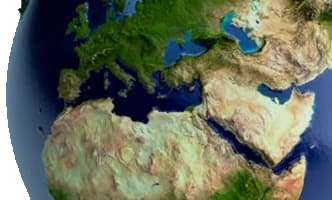What is the history of negotiations over the climate regime, what has been achieved and what does the future of this process look like?
1. The Development of the Climate Regime
The modern scientific history of global climate change goes back to the late 1950s. For the next two decades it was exclusively a scientific issue discussed among scientists and between scientific institutions. In the 1980s it reached the international political agenda and in 1988 the Intergovernmental Panel on Climate Change (IPCC) was established. In 1989 formal negotiations under the auspices of the UN started and the Framework Convention on Climate Change (UNFCCC) was adopted at the Rio Summit in 1992. The Kyoto Protocol was adopted in 1997, but agreement on how the Protocol should be interpreted was not achieved until the Marrakech Accord in 2001. It took another four years of ratifications before the protocol came into force (2005). The next milestone was the adoption of the Bali Roadmap in 2007, marking the start of the negotiations over a follow-up to the Kyoto Protocol, leading to the Copenhagen Accord at COP 15 in 2009. In short, negotiations over a climate regime has now gone on for more than two decades. What has been achieved?
2. Achievements
Judging what has been achieved depends upon the measurement rod applied. If a cognitive approach is chosen, knowledge about this extremely complex problem has increased strongly, not least due to the massive scientific effort by the IPCC. On the political front progress has also been made in terms of new and innovative approaches like quota trading, the Clean Development Mechanism (CDM) and Reducing Emissions from Deforestation and Forest Degradation in Developing Countries (REDD). If we contrast the achievements with the goal of this regime as well as scientific advice, however, progress is exceedingly modest. The Parties have made commitments to a long-term goal of stabilizing atmospheric GHG concentrations at a level that ‘would prevent dangerous anthropogenic interference with the climate system’ (UNFCCC/Art.2). This has later been translated into a seemingly modest goal of avoiding more than a 2 degree Celsius temperature increase. Based on the regulations agreed upon there is no chance to reach this goal. Even in the unlikely event of full compliance with the Kyoto Protocol it will have a very modest effect on the temperature increase and the Copenhagen Accord represents no improvement in this regard. Scientists have long warned that strong emission reductions are necessary but emissions are increasing at an accelerating rate.
It is not difficult to explain the modest progress. This problem is extremely ‘malign’ as it is characterized by deep political conflicts. The North-South conflict is most profound and disagreement over fairness, historical responsibility and differentiated commitments looms large. More generally, the benefits of abatements are long-term and diffuse while costs tend to be up-front and concentrated, making forceful action exceedingly difficult.
Still, when contrasting achievements with the enormous global political and institutional efforts, questions can be posed on the effectiveness of the UN process. Let us just consider the process since the adoption of the ‘Bali-Roadmap’ in 2007. In 2008 four global rounds of negotiations were arranged prior to COP 14 in Poznan. Still, essentially nothing was achieved because two key actors did not take an active part. The US was passive as the outgoing Bush Jr. administration had no real negotiation mandate and the EU was preoccupied with its own internal negotiations. UN efforts were strengthened even more in 2009 to have a text ready well in advance of COP 15 and five global conferences took place prior to Copenhagen. They were all characterized by strong polarization and lack of progress. The new US administration was more positive to action than the previous one, however, the financial crisis and calls for a health reform prevented the adoption of a Climate Law before COP 15. Already before Copenhagen it therefore became clear that the goal of a legally binding approach would not be achieved.
The Copenhagen meeting itself was also no victory for the UN and multilateral diplomacy. When the state leaders arrived there was no text whatsoever so the risk of a fiasco was imminent. The main reason was again the deep-seated conflict between the North and the South. The EU had accepted only one negotiation track promoted by the US in order to get the emerging large economies to take on some kind of commitments. The South, however, wanted the two-track approach to be continued – a Kyoto approach for the developed countries and a UNFCCC track for the South (Annex II Parties). It was not multilateral diplomacy that saved the Copenhagen meeting from disaster, but exclusive negotiations behind closed doors among a handful of nations, the US and the so-called BRIC countries (Brazil, India, China and South Africa). The outcome was 2 ½ pages, the Copenhagen Accord. In line with US preferences this was a soft-law ‘pledge and review’ document, in stark contrast to the top-down and legally binding approach of the Kyoto Protocol. Besides the US, China was most important in influencing the outcome and successfully stripped the document of most numerical obligations. Most Parties accepted the Accord as the best outcome possible to reach – although many were dissatisfied. A few developing countries, however, did not accept it and its legal standing is therefore highly uncertain. There are different opinions on the Accord. In the US it is viewed as a decent start, a stepping stone for further negotiations. In contrast, most European voices are negative, seeing it more as a ‘side-step’ than a stepping stone.
3. The Future of the Climate Regime
Although there are different opinions on the Copenhagen Accord, considering the massive global effort it is hard to escape the conclusion that it reminds us of the metaphor of the ‘mountain that gave birth to a mouse’. Considering the lack of progress and the fact that the end game was decided by a handful of nations behind closed doors it questions both the significance of multilateral diplomacy as well as the role of the UN. To secure the legitimacy of process as well as results, the UN is also needed further down the road, but considering the modest progress alternative and more exclusive forums among major economies (and emitters) are needed as well. Various co-operative ventures along these lines exist and need to intensify efforts. They reflect the new geo-political realities as they all include the emerging economies. Under real life circumstances we see that the major emitters call the final shots, regardless of framework, but if progress is made in more limited forums, results need to be channeled into the UN process to secure interaction and coordination between various approaches. Considering it took more than seven years before the Kyoto Protocol was ratified, a legally binding follow-up is a distant dream. Economic recession and factors unrelated to climate change have so far been more important in bringing emissions down than concerted global efforts. Considering the expected long-term growth in populations and economies of developing countries there is little reason for future optimism.
References
- Andresen, S. and Skodvin, T., ‘The Climate Regime: Achievements and Challenges’ in D Vidas and J.P Schei (eds) The World Ocean in Globalisation: Challenges and Responses, Leiden/Boston: Martinus Nijhoff Publishers/Brill (Forthcoming 2010)
- R?geberg, O., Andresen, S., and Holtsmark, B., ‘International Climate Treaties : The Case for Pessimism, Climate Law 1 (2010) (Forthcoming).
About the author

Steinar Andresen
Senior Research Fellow, Fridtjof Nansen Institute, Norway


